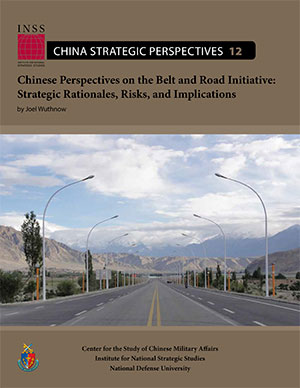Download PDF
Executive Summary
 Chinese officials have downplayed the security dimensions of Xi Jinping’s signature foreign policy initiative—the Belt and Road Initiative (BRI). However, Chinese strategists have extensively analyzed three major issues: strategic benefits the BRI can provide for China, key security risks and challenges, and ways to reduce those risks. This study surveys their views and comments on implications for U.S. strategy. Key findings include:
Chinese officials have downplayed the security dimensions of Xi Jinping’s signature foreign policy initiative—the Belt and Road Initiative (BRI). However, Chinese strategists have extensively analyzed three major issues: strategic benefits the BRI can provide for China, key security risks and challenges, and ways to reduce those risks. This study surveys their views and comments on implications for U.S. strategy. Key findings include:
The main strategic benefits of the BRI include bolstering regional stability, improving China’s energy security, and amassing influence in Eurasia.
- Chinese analysts see Eurasian integration as a way to create a more stable security environment around China’s southern and western periphery by addressing the underlying sources of violence and building mutual trust. Another benefit is increasing China’s energy security by diversifying oil and natural gas supply and transport routes.
- Several analyses describe the BRI as a way for China to simultaneously achieve two geopolitical objectives: amassing strategic influence in Eurasia’s heartland while deftly avoiding direct competition with the United States. Some sources, however, are more explicit in portraying the BRI as a response to U.S. pressure, especially that posed by the Barack Obama administration’s rebalance to Asia policy.
Implementing BRI projects could be frustrated by domestic and regional instability, nontraditional security threats, and strategic balancing from other major powers.
- Chinese sources—including Xi Jinping himself—portray the BRI as unfolding within a turbulent and, in some ways, deteriorating security environment.
- Key operational challenges include regional conflict and protecting property and personnel from “radical” groups, such as Uighur separatists, the so-called Islamic State, and Pakistani militants, although Chinese sources rarely acknowledge that anti-China sentiment stemming from policies such as exclusive use of Chinese labor could be contributing to that violence.
- Chinese observers closely follow perceptions of the BRI in states such as the United States, Japan, and India, and assume that all three will respond individually or collectively to oppose China’s ambitions, or have already done so. Lesser concerns are raised about Russia and Southeast Asian states.
China will have to marshal military, intelligence, diplomatic, and economic tools to counter perceived threats to the BRI’s long-term viability.
- While some Chinese sources advocate greater expeditionary naval and ground force capabilities as a means to protect overseas equities, others argue that many challenges can be reduced through private security forces and host nation support. Mitigating threats to Chinese overseas interests also requires stronger risk assessment capabilities and enhanced nontraditional security cooperation, especially in the counterterrorism arena.
- Many Chinese writings argue that strategic competition can be avoided by co-opting other major powers, such as by including U.S. companies in key BRI projects, and by carefully avoiding encroaching in other states’ spheres of influence. Many also call for a more attractive strategic message to enlist supporters and calm detractors.
U.S. strategy should seek to check China’s geopolitical ambitions while advancing mutually beneficial cooperation where possible.
- The most negative outcome for the United States would be a Sinocentric Eurasian order in which Beijing locks countries into exclusive economic relationships and U.S. interests are marginalized.
- China’s ability to pursue an exclusive regional sphere of influence hinges on variables including China’s interests in maintaining stable relations with the United States, the willingness of other major powers to check China’s aspirations, and the ability of BRI partners to avoid overreliance on China’s economic largesse.
- U.S. strategy should aim to preserve the strategic balance in Eurasia by maintaining strong U.S.-China economic relations, encouraging alternative regional infrastructure development plans, and remaining a committed partner to states across the continent. However, this does not preclude U.S.-China cooperation in areas of shared interest, such as in the counterterrorism domain. The mix of competitive and cooperative responses to the BRI should facilitate larger U.S. strategic aims in the region and vis-à-vis China.
Read more →